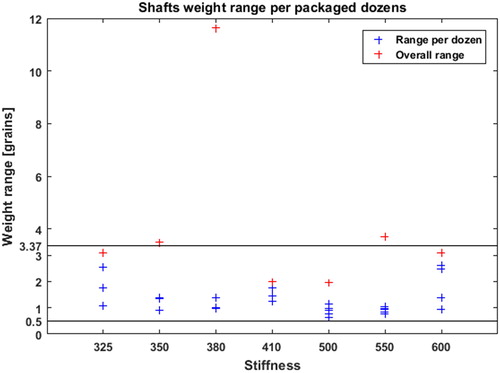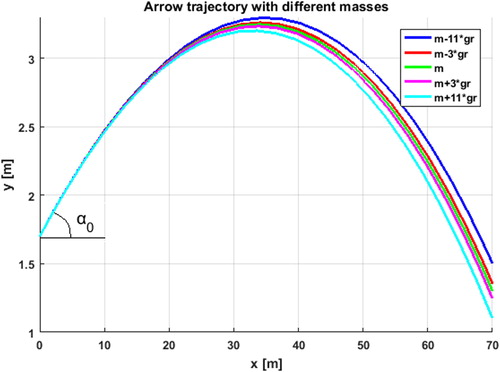 ?Mathematical formulae have been encoded as MathML and are displayed in this HTML version using MathJax in order to improve their display. Uncheck the box to turn MathJax off. This feature requires Javascript. Click on a formula to zoom.
?Mathematical formulae have been encoded as MathML and are displayed in this HTML version using MathJax in order to improve their display. Uncheck the box to turn MathJax off. This feature requires Javascript. Click on a formula to zoom.1. Introduction
Olympic target archery is a precision mechanic sports. It consists in shooting at a 122 centimetres target set 70 metres away with a recurve bow. The target is composed of ten concentric circles. The inner-most circle is the smallest one (12.2 cm) and gives the highest possible points. Archery can be considered as a concentration sport, where stability and repeatability are the most important qualities.
Precision in archery depends also on the mechanical properties of the bow used and the mechanical properties of the arrows that are shot. The provider of most archery Olympic medals, Easton Archery (USA), guarantees that the weight between two shafts from the same packaged dozen does not exceed 0.5 grains (≈ 0.032 grams).
In a context of high density among the world top level archers and countries, the French archery federation (FFTA) wishes to assess the quality of the arrow shafts used for training or competition and quantify the impact of weight shafts variations on target.
2. Methods
An archery arrow is composed of a shaft, a point, three fletchings and a nock. The arrow shaft represents roughly 2/3 of its total mass. In this study, only the variation of the shaft weight is considered.
Twenty-six dozens of X10 arrow shafts (Easton Archery, USA) of different arrow stiffness used for the Olympic Games were chosen. The selection includes three dozens of stiffness 325, 350, 380, 410, five dozens of 500, 550 and four dozens of 600.
The arrow shafts were weighted on a scale (A&D FZ-200i, Japan). The scale readability is 0.001 grams with a standard deviation of 0.001 grams.
To verify the weight specification given by Easton Archery, weight range per dozens was calculated. Since the archers mix shafts from different dozens of the same size, the weight range across every shafts of the same size are also studied.
In this preliminary study, the energy losses due to friction for the arrow system are neglected. Hence, the total energy is the sum of the kinetic energy and potential energy. During the aiming phase, the system arrow is at equilibrium. When the archer reaches full draw, potential elastic energy () is stored in the bow limbs. After the release, the bow elastic energy is transformed into kinetic energy (
) via the nocking point (
).
(1)
(1)
(2)
(2)
From EquationEquations (1)(1)
(1) and Equation(2)
(2)
(2) derives the relation between the velocity of the arrow (
) right after the release, its mass (
) the energy of the bow (
).
(3)
(3)
After being released, with an initial velocity (), height (
) and angle (
), the arrow is under the influence of its weight (
) and air resistance (
).
(4)
(4)
(5)
(5)
with
the gravitational acceleration on Earth,
the density of the air,
the drag coefficient,
the velocity of the arrow relative to the air,
its direction and
the cross sectional area of the arrow.
Applying Newton’s second law,
(6)
(6)
Assuming that the initial velocity of the arrow is contained only in a plane (), it derives the acceleration on both axes:
(7)
(7)
With the initial conditions:
To obtain the trajectory of the arrow, the differentials equations are solved numerically.
3. Results and discussion
presents the weight range within each packaged dozen. It appears that none of the dozens respects the weight specification given by the manufacturer. The analysis of weight range of the shafts within a same size highlights the difference of 11.64 grains between the lighter and heavier 380 shaft. For all the other stiffness, the overall ranges values went from 1.96 to 3.69 grains.
From EquationEquation (3)(3)
(3) , for equal bow energy, the velocity of the arrow after release decreases if its mass increases. Moreover, EquationEquation (7)
(7)
(7) show that the arrow mass will also affect its acceleration on both axes. The equations are solved with Matlab basic ordinary differential equations solver ode45 to give the trajectory of the arrow in the plane (
).
Realistic parameters are selected for the computation. The bow energy, initial angle and baseline mass are chosen such as the arrow hits the target centre, set approximately at 130 cm, 70 metres away according to World Archery rulebook. m.s−2,
J,
m,
(Miyazaki et al. Citation2013),
(≈ 360.5 gr),
kg.m−3,
m2
sums up the different height impact relative to the target centre for the weight ranges measured.
Table 1. Impact height at 70 m with different masses.
According to Easton weight specification, an arrow heavier than the baseline arrow by 0.5 grains hits the target 0.87 cm lower. For arrows 0.5 grains lighter, the impact height is 0.94 cm higher.
displays different trajectories obtained with varying arrow masses (11 grains). Assuming that the shots are perfectly duplicable in the same exact conditions, for the baseline mass
chosen, others same stiffness arrows weight should be ranged between
and
grains to keep arrows in the 10 points zone (130
6.1 cm). For the shafts weighted, each dozens shots separately with the same initial conditions would give the maximum score. However, looking at the overall mass range in , only 325, 410, 500 and 600 shafts are below 3.37 grains. Since archers mix the arrow shafts and shoot multiple arrows with the same bow settings, it is expected that just with shafts weight variations, scores should range from 7 to 10 points (130
24.4 cm) for 380 shafts. For 350 and 550 shafts scores are expected to be at least 9 (130
12.2 cm). Else, all the arrows are in the 10 points area.
4. Conclusions
The aim of this study was to assess the characteristics of the raw shafts provided by Easton in France. After analysis of the shafts weight, it was shown that for each shaft stiffness tested, none of the packaged dozens respected the manufacturer specifications. Moreover, variations of shafts weight impact the exit velocity of the arrow after the release and its acceleration, thus induces a different target impact height or score according to the simplified model.
However, this model does not consider the stiffness of the arrow. The arrow bends around the bow after the release, inducing a lateral deflection. In order to limit the variability of the arrow shafts, future work will consist in measuring other mechanical properties such as their stiffness or diameter to quantify their influence on the scores for a whole target and select shafts with the same mechanical characteristics.
Additional information
Funding
References
- Miyazaki T, Mukaiyama K, Komori Y, Okawa K, Taguchi S, Sugiura H. 2013. Aerodynamic properties of an archery arrow. Sports Eng. 16(1):43–54.


